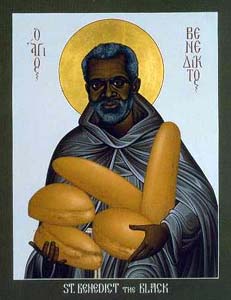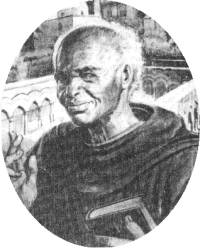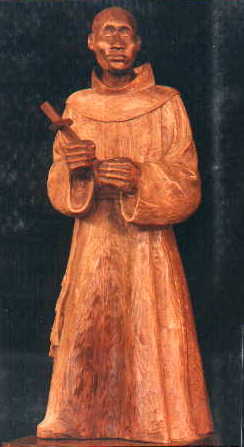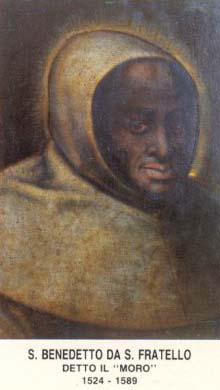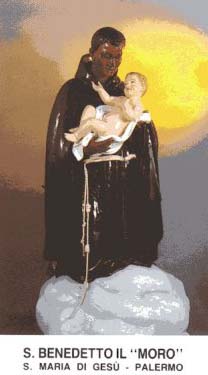인창동성당 게시판
|
4월3일(4월4일) 산 프라텔로의 성 베네딕토 블랙♬Benedictus-빈소년합창단 |
|---|
|
베네딕토는 ’좋게 말한’ 또는 ’축복된’이란 뜻이다. 그는 아프리카 계통의 부모 밑에서 태어났는데 그의 부모는 메시나 근처에서 노예로 일했다고 한다. 그러나 베네딕토는 시실리에서 태어났으며 어릴적에 그의 주인으로부터 자유를 얻었다. 그가 유색인종이기 때문에 공적으로 해를 입었을 때 그의 나이가 21세였다. 그러나 그는 대단한 인내심과 놀라운 인품을 드러냄으로써 이 위기를 극복하였고, 프란치스코 은수자 그룹에 들어갔다. 1564년애 이 그룹이 해산되자, 베네딕토는 팔레르모의 프란치스꼬회 수도자들로부터 인정을 받아 평수사로 입회하였다. 1578년에 새 원장을 뽑을 때, 평수사인 베네딕토가 선출되었는데, 그는 단순한 수도자였고, 전혀 아는 체 하지 않는 점이 모든 이들의 마음을 사로잡았기 때문이다. 하는 수 없이, 그는 이 직책을 수락하여, 성공적으로 원장의 직무를 수행하였고, 프란치스코회의 규칙을 글자 그대로 실행하려고 노력하였다. 후일 그는 수련장까지 겸하였다. 그의 이해심과 동정심은 치유의 은사를 받은 사람으로 명성을 얻게 하여, 수많은 사람들이 그를 찾아와 도움을 청하였다. (성바오로수도회홈에서)
St Benedict the Moor Wood(Linden) Commissioned by St Anthony Church in Greenville,SC. in 1994. Height: 5’
성서에 "하느님께서는 모든 인간을 차별없이 대하십니다"(로마 2,11) 하신 것처럼 하느님께서는 쉽게 틀릴수 있는 인간의 판단과는 달라서 마음속까지 들여다보시는 전지(全知)의 판단을 하시고 모든 이에게 풍부한 은총을 베풀어주신다. 이제 말하려고 하는 흑인 성 베네딕토도 그 좋은 예 중의 하나라고 볼 수 있다. 그는 노예로서 무식했지만 하느님의 은총을 헛되이 쓰지 않고 완덕에 이르려 성심껏 노력한 결과, 위대한 성인이 되어 전 그리스도교 신자들에게 존경을 받고 있다.
이 성인은 1526년 이탈리아의 메시나 부근에서 태어났다. 부모는 모두 노예 계급에 속한 흑인이었지만, 어머니는 일찍이 자유의 몸이 되었고, 또한 장남인 베네딕토도 같이 해방시켜 주도록 약속이 되어 있었다. 신분상으로는 정말 비천했지만,양친은 모두 신심이 깊어 자녀를 극히 경건한 사람으로 교육시켰다. 베네딕토는 장성하자 일찍부터 목동으로 소나 양을 지키는 일을 하게 되었다. 그는 틈을 내어 늘 기도나 묵상을 했고 그럴 때마다 성령께서 친히 그에게 지혜를 비추어 주셨다. 그는 겸손의 덕을 닦을 기회를 많이 가지고 있었다.왜냐하면 다른 목동들은 그의 성실한 점에 감탄하면서도 한편으로는 그의 얼굴빛이 검고 신분이 천한 것을 항상 조소했기 때문인데 그럴 때마다 그는 비상한 인내심으로 모든 것을 참아 내었다. 그리고 여전히 어느 누구에게든지 사랑으로써 친절히 대했다. 이와 같은 그의 덕행은 하느님께 의합하게 되어 한층 더 풍부한 은총을 받게 되었다.
18세 때에 그는 밭을 갈기 위해 황소 두 마리를 사들였다. 어느 날 그가 밭을 갈고 있을 즈음, 그 근방에 유명한 귀족 출신의 란자라는 한 은수자가 그 곁을 지나가게 되었는데, 그때 다른 농부들이 베네딕토를 희롱하는 것을 보고 그들을 꾸짖으며 ’이 사람은 훗날 반드시 훌륭한 사람이 되어 유명해 질 것이다"라고 말했다. 그리고 나서 2, 3일 후에 그 은수자는 다시 밭을 갈고 있는 베네딕토에게 와서 "여기서 그런 일만 하면 무슨 소용이 있느냐?" "소 같은 것은 다 팔고 나를 따라오너라."고 말했다. 베네딕토는 마치 옛날 주님께 부르심을 받은 사도들과 같이 즉시 그의 말에 순종했다.
그 은수자에게는 이미 몇 명의 제자가 있었으므로, 교황 율리오 3세는 그의 한 단체를 작은 수도원으로서 인가해 주었다. 사람들은 이 회원들의 성스러운 생활에 감탄하여, 사방에서 교훈을 얻으려 모여들었다. 그러나 회원들은 오히려 그것을 귀찮게 생각하고 오로지 기도와 묵상을 하기 위해 다른 조용한 곳으로 이사했다. 그러나 그곳에서도 오래지 않아 사람들에게 발견되지 않을 수가 없었다. 더구나 베네딕토의 기도에 의해 불치의 종기병 환자가 완치된 후부터는 그 수도원을 찾아오는 이가 더욱 증가했다. 수도자들은 또다시 고요한 곳을 찾아 떠나지 않으면 안 되었다. 그러던 중 그 회의 창립자 란자가 주님의 부르심을 받아 승천하자 사람들은 베네딕토를 후임 원장으로 추대했다. 그는 1562년까지 원장지기에 있었는데 그해 교황 비오 4세의 명령에 의해 이 수도원은 프란치스코회와 합치게 되어 베네딕토는 평수사로서 팔레르모 수도원에서 지냈다.
그 수도원에서 그는 규칙을 엄수하면서 단식재도 자주 지키는 등 다른 동료들보다 모든 면에서 열심히 모범을 보였으며 게다가 항상 온순하고 겸손하며 명랑했다. 그의 맡은 일은 요리하는 것이었지만, 그는 진실히 자신의 임무를 완수하며 틈만 있으면 늘 열심히 기도했다. 종종 기도에 몰두하며 부엌일을 잊은때도 있었지만 기이하게도 천사가 대신 식사 준비를 해 주곤 했다.
어떤 때는 요리할 생선이 없어서 쩔쩔매는 때도 있었다. 그러나 베네틱토는 실망하지 않고 열심히 하느님께 도우심을 구하며 물통 몇 개에 물을 부었더니 즉시 펄펄 뛰는 물고기가 넘치도록 그 안에 생겨서 모든 사람들이 실컷 먹고도 남았다고 한다. 이와 같은 기적이 몇 번이나 일어났는지 모른다. 하느님께서는 베네딕토의 순진한 마음과 깊은 신앙을 어여삐 보시고 이런 특별한 보수를 내려 주신 것이다.
1578년, 그는 팔레르모 수도원의 원장에 취임하게 되었는데, 이때 수도원내의 수사들이 만장일치로 천거한 것을 보더라도 흑인인 그가 얼마나 순진하고 모든 이에게 존경을 받고 있었는가를 가히 짐작할 수가 있다. 그는 공부를 많이 하지 못해서 읽거나 쓰는 것조차 모르는 인물이었지만, 학식많은 사제나 유명한 강론가도 기꺼이 그의 명령에 순종했다. 그것은 그의 성덕이 모든 사람들을 승복하게 한 것이라 생각된다.
그는 설교할 때 성서를 정확히 설명해 줌으로써 사람들에게 깊은 감명을 주었다. 청중들은 성령께서 친히 그의 입을 빌어 말씀하시는 것같이 생각했다. 9년 후 수련장이 되어서도 그는 자신의 책임을 완수했다. 그는 성 바오로사도의 말씀대로 "모든 이에게 모든 것이 되는 자"(1고린 9, 22 참조)였다. 그는 여행을 하는 때도 있었는데 그때마다 큰 곤란을 겪었다. 세상 사람들은 그를 성인처럼 공경하여 한 번이라도 그의 얼굴을 보고 싶어서 대대적으로 그를 환영했기 때문이었다. 그러므로 그는 항상 밤에 여행을 해야 했다.
3년간 수련장의 임기를 채운 베네딕토는 겸손하게도 그 후부터는 다시 부엌에 가서 요리를 담당했다. 그러나 여전히 그의 도움을 간구하는 사람들은 조금도 그칠 줄을 몰랐다. 얼마 뒤 그는 몸이 쇠약해지고, 그러던중에 열이 심해졌다. 그는 자기 임종 날짜를 예언했다. 이미 예언된 날 즉 1589년 4월 3일, 눈물 속에 성체를 모시고 모든이의 용서를 빌고 예수와 마리아의 이름을 부르며 다음날 고요히 승천했다. 그 날은 마침 성목요일이었다. 지금 그는 팔레르모 시의 주보 성인으로 공경을 받고 있다. (대구대교구홈에서) 그러나 그는 대단한 인내심과 놀라운 인품을 드러냄으로써 이 위기를 극복하였고, 프란치스코 은수자 그룹에 들어갔다. 1564년에 이 그룹이 해산되자 성 베네딕투스는 팔레르모(Palermo)의 작은 형제회 수도자들로부터 인정을 받아 평수사로 입회하였다. 1578년에 새 원장을 뽑을 때 평수사인 성 베네딕투스가 선출되었는데, 그는 단순한 수도자였고 전혀 아는 체 하지 않는 점이 모든 이들의 마음을 사로잡았기 때문이었다. 하는 수 없이 그는 이 직책을 수락하여 성공적으로 원장의 직무를 수행하였고, 작은 형제회의 규칙을 글자 그대로 실행하려고 노력하였다. 후일 그는 수련장까지 겸하였다. 그의 이해심과 동정심은 치유의 은사를 받은 사람으로 명성을 얻게 하여 수많은 사람들이 그를 찾아와 도움을 청하였다. 만년에는 그가 처음에 하던 부엌일을 하면서도 아주 평화스럽게 생활하였다. 그가 '흑인 베네딕투스'라 불리는 이유는 흑인이기 때문이 아니라 누비아족(홍해 지방의 민족)이기 때문이라고 한다. 그는 4월 4일 이탈리아 팔레르모에서 선종하였으며, 1743년 5월 15일 교황 베네딕투스 14세(Benedictus XIV)에 의해 시복된 후 1807년 5월 24일 교황 비오 8세(Pius VIII)에 의해 성인품에 올랐다.
♬Benedictus-빈소년합창단
San Benedetto il Moro Religioso Copatrono - con santa Rosalia - della diocesi di Palermo, Benedetto Manassari nacque a San Fratello (Messina) nel 1526 da genitori discendenti di schiavi africani. A 21 anni entrò in una comunità eremitica e visse sul Monte Pellegrino. Quando Pio IV sciolse la comunità, passò ai Frati minori. Visse 24 anni nel convento di Santa Maria di Gesù a Palermo come cuoco, superiore, maestro dei novizi, infine ancora cuoco. Morto nel 1589 è santo dal 1807. (Avvenire) Etimologia: Benedetto = che augura il bene, dal latino Martirologio Romano: A Palermo, san Benedetto Massarari, detto il Moro per il colore della sua pelle, che fu dapprima eremita e, divenuto poi religioso nell’Ordine dei Frati Minori, si mostrò umile in tutto e sempre pieno di fede nella divina Provvidenza.
Autore: Giuseppe Morabito Fonte:
His parents, Christopher and Diana, were slaves who had been taken from Africa to Sicily. Benedict was granted his freedom at age 18, but remained as an employee of his former master. Scorned and mocked by others as poor as himself, due to his origin and skin, he retained a natural cheerfulness. He met with, and became enamored of a group of Franciscan hermits near Palermo. Benedict sold what little he had, gave away the money to the poor, and joined this group. Novice master and reluctant superior of the friars in Palermo. When his term ended, he happily returned to working in the friary kitchen. Benedict never referred to possessions as “mine” but always “ours.” He had gifts for prayer and the guidance of souls. His humility and cheerfulness set an example that helped reform his order. On his death, King Philip III of Spain paid for a special tomb for the simple friar. Benedict was not a Moor, but the Italian “il Moro” for “the Black” has been misinterpreted as referring to a Moorish heritage. Born
Because he was a model for all the brethren of the convent, he was appointed their superior, even though he was only a lay brother without any schooling. His holy example, his humble charity and self-abnegation had the effect that not only did no one despise him in his office, but rather was he venerated by all, and the inmates of the convent advanced in all virtue during his administration. At the expiration of his term of office, he went back to his duties in the kitchen with greater joy than he had previously entered upon his duties as superior. In his 63rd year he was attacked by severe illness, which he recognized as his last. With profound devotion he received the last rites of the Church, and departed this life on April 4, 1589, at the hour he had foretold. Several years later his body was found still incorrupt, and emitting a pleasant odour. Veneration for him soon spread from Palermo through Italy, to Spain and Portugal, even to Brazil, Mexico, and Peru. Pope Benedict XIV declared him blessed, and Pius VII solemnly placed him in the ranks of the saints in the year 1807. GOD IS NO RESPECTER OF PERSONS
St. Benedict of San Philadelphio (Or BENEDICT THE MOOR)
Born at San Philadelphio or San Fradello, a village of the Diocese of Messina in Sicily, in 1526; d. 4 April, 1589. The parents of St. Benedict were slaves from Ethiopia who were, nevertheless, pious Christians. On account of their faithfulness their master freed Benedict, the first-born child. From his earliest years Benedict was very religious and while still very young he joined a newly formed association of hermits. When Pope Pius IV dissolved the association, Benedict, called from his origin Æthiops or Niger, entered the Reformed Recollects of the Franciscan Order. Owing to his virtues he was made superior of the monastery of Santa Maria de Jesus at Palermo three years after his entrance, although he was only a lay brother. He reformed the monastery and ruled it with great success until his death. He was pronounced Blessed in 1743 and was canonized in 1807. His feast is celebrated 3 April.
Benedict the Black, OFM (RM) (also known as Benedict the Moor) Born near Messina, Italy, in 1526; died at Palermo, Italy, April 4, 1589; beatified in 1743; canonized in 1807. Benedict was the son of freed negro slaves of Sicily. He was about 21 when he was publicly insulted on account of his race, and his patient and dignified demeanor on that occasion was observed by the leader of a group of Franciscan hermits. Benedict was invited to join the group at Montepellegrino. When their superior died, he was made superior of the community. When he was about 38 (1564), Pope Pius IV disbanded communities of hermits and they were absorbed into the Friars Minor of Observance. Thus, Benedict became a Franciscan lay brother and the cook at Saint Mary’s monastery near Palermo.
In 1578, Benedict was appointed superior (guardian) of the convent when it opted for the reform, though he was an illiterate laybrother. With understandable reluctance he accepted the office, and, rule with many evidences of direct supernatural aid, successfully carried through the adoption of a stricter interpretation of the Franciscan.
After serving as superior, he became novice master but asked to be relieved of this post and returned to his former position as cook. Benedict’s reputation for holiness, working miracles, and as a sympathetic and understanding religious counsellor brought hordes of visitors to see the obscure and humble cook.
Saint Benedict is the patron of African-Americans in the United States. The surname ’the Moor’ is a misnomer originating from the Italian il moro (the black) (Attwater, Attwater2, Benedictines, Delaney, Encyclopedia, Gill).
|


